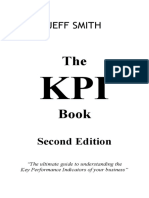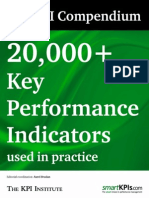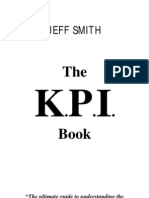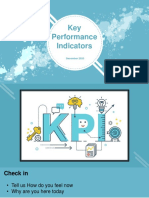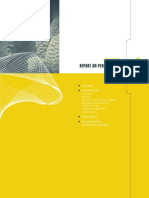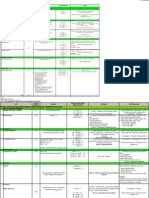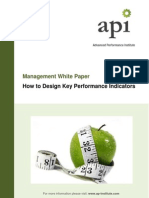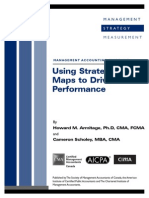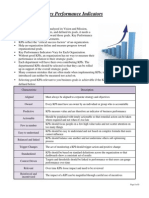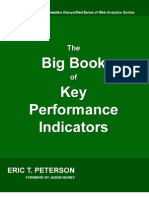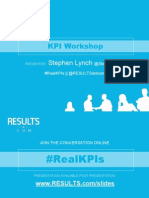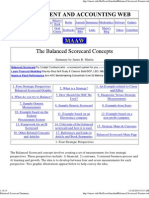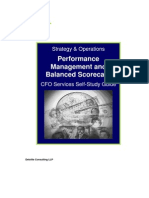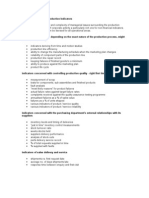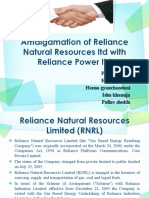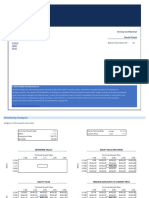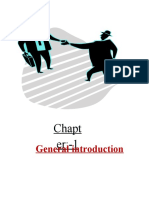Business KPI's
Business KPI's
Uploaded by
Jonathan MoralesCopyright:
Available Formats
Business KPI's
Business KPI's
Uploaded by
Jonathan MoralesOriginal Description:
Copyright
Available Formats
Share this document
Did you find this document useful?
Is this content inappropriate?
Copyright:
Available Formats
Business KPI's
Business KPI's
Uploaded by
Jonathan MoralesCopyright:
Available Formats
Table of Key Performance Indicators
Table of Key Performance Indicators
Table of Key Performance Indicators
Contents
Table of Key Performance Indicators_________________________________________2 Customers_______________________________________________________________2 Sales____________________________________________________________________4 Innovation & Growth_______________________________________________________5 Marketing________________________________________________________________5 Employees_______________________________________________________________6 Financial_________________________________________________________________8 Turnover________________________________________________________________10 Revenue________________________________________________________________10 Expense________________________________________________________________10 Productivity and Efficiency ________________________________________________13 Quality _________________________________________________________________15 New Product Development_________________________________________________17
Cash Management _________________________________________________19 Risk Management__________________________________________________19 Capital Investments ________________________________________________20 Safety and Environment_____________________________________________20 Credit/Collections__________________________________________________20 Purchasing and Accounts Payable____________________________________21 Sales Operations __________________________________________________21 Accounting _______________________________________________________22 Information/Technology_____________________________________________22 Suppliers_________________________________________________________22 Community _______________________________________________________23
Table of Key Performance Indicators
Table of Key Performance Indicators
Customers Customer Satisfaction Average survey scores in each area of concern Customer satisfaction ratings from surveys, which may include questions addressing any or all of the following matters: Brand value Customer intent to repurchase Customer perception of aesthetics Customer perception of availability Customer perception of ease to work with Customer perception of financing Customer perception of hidden or indirect costs Customer perception of quality of outputs Customer perception of reliability Customer perception of serviceability Customer perception of warranties Customer rating Price Product quality Satisfied customer index# Service attributes such as timeliness, responsiveness, understanding of needs of customer/customers business, quality of relationship, knowledgeable staff, customer focus, and proactivity Service quality Market perceived value
Partnering index-Rating by customer relationship with organization, including such things as involvement in planning, involvement in projects, investment in product and services (e.g., information technology) Percent of survey respondents giving each grade (for example, on a 1-5 scale) Referral customers Separate analysis of the survey scores of the most important, valuable, or profitable customers Profitability of each customer (sales and cost of sales for each customer) Percent of unprofitable customers Customers satisfaction with products/services as compared to satisfaction with those of competitors Share of purchases made by customers (that is, the portion of the customers purchases that go to the organization versus their purchases from competitors, sometimes called share of wallet) Quality Claims Customer complaints Customer perception of quality of outputs per survey Customer perception of reliability per survey Errors in order fulfilment, such as wrong items shipped, shipments not made, incorrect billings (total number or as a percent of orders taken) Number of customer complaints
Table of Key Performance Indicators
Product return rates Returns Returns as a percentage of sales Total product returns (dollars or units) Warranty claims Warranty claims as a percentage of sales or shipments
Service Price Direct Price Price relative to competition Total cost to customer (relative to competition Average number of customers per week with unsolved problems Average response time per customer request Average response time to solve customer problems Customer complaints resolved Customer perception of ease to work with per survey Number of customer complaints resolved on the first contact Number of potential orders that had to be declined Percent of delivery deadlines met (compared to either the date requested or promised) Percentage of customer problems solved within stated time frame (say, 48 hours) Rate of responses exceeding specified time frame (for example, 24 hours) Sales versus first request date Service attributes such as timeliness, responsiveness, understanding of needs of customer/customers business, quality of relationship, knowledgeable staff, customer focus, and proactivity per survey Service quality rating per survey
Customer Retention Average customer duration with company (months) Average duration of customer relationship Customer retention rates Customer turnover rates Customers lost (# or %) Lost business revenues compared to market average Net customer gains Number of dormant customers (for example, those who have not purchased anything in six months)
Table of Key Performance Indicators
Percent of customers who are repeat customers Percent of new business done with repeat customer Percent of revenue from existing customers Ratio of customers with no sales activity in last six months to total customers Repeat customers
Sales Sales Volume Annual sale per customer Average sale amount (per transaction) Average sales per customer Average sales price per unit Customer revenue list Frequency (number of sales transactions) Growth rate, for each significant product or product line Order backlog Profitability of each product/service or product/service line Sales orders taken ($) Sales per other relevant unit, such as sales per square foot Sales per relevant unit, broken down by geographic area or product line
Sales Mix Growth rates by product Percents of sales from each distribution channel Percent of sales from each product/service or product/service line Percent of sales from new products Percent of sales from products whose patents will expire within a year Percent of sales of one product from customers who also bought a companion product Percent of unprofitable products/services Revenue generated from customer segments (e.g., new affluent; large versus small; industry; region) Sales to major customers
Existing Customer Average sales per repeat customer Number of customers (#) Percent of new business done with repeat customers Percentage of growth in the average sales per repeat customer
Table of Key Performance Indicators
Share of purchases made by customers (that is, the portion of the customers purchase that go to the organization versus their purchases from competitors, sometimes called share of wallet)
Innovation & Growth New Customer Average sales per customer Growth in number of new customers New customers Number of new accounts opened Number of prospects Percentage of customers received by referral Revenues from new customers/total revenues (%)
New Products Increase in major projects-count of number of projects over a specified dollar value Number of new products introduced by competitors Percent of revenue from target market segment Percent of revenues generated from products developed in the last xx months Ratio of new products (less than 2 years old) to full company catalog (%) Ratio of new products (less than 2 years old) to product family
Marketing General Additional sales made to existing customers through referrals or cross-selling Amount of time spent with customers or potential customers Customers/employee (#) Gross margin per sales call Marketing cost as a percent of sales Marketing cost per new customer obtained Number of ads placed Number of industry trade shows attended Number of people who are exposed to the ads (available from the newspaper, magazine or other medium that carries the advertisement) Number of presentations made Number of proposals made Number of times the organization or its products are mentioned in periodicals or broadcast media Orders per sales call
Table of Key Performance Indicators
Percent of public aware of, or favourably disposed toward, the product/service (based on surveys) Responses rate (responses as a percentage of those exposed) Responses to marketing efforts (calls to the companys 800 number for information, postage-paid cards returned, website hits, average user time spent at website) Total advertising or marketing costs
Market Penetration Brand recognition (percentage of potential customers who recognize company brand based on Brand recognition (that is, the percent of potential customers who know of the organisations product or service or who think highly of it), which is generally done through surveys Market potential ($) Market share (that is, the companys share of total sales in the geographic areas in which it competes) done on a product or product line basis Number of channels in which the product is available Number of customers Number of new customers Percent of proposals made that were accepted Sales to new customers as a percent of total sales surveys)
Employees Competencies Competence development expense/employee Cross-department (or cross-functional) assignments Hours of training per employee Per capita annual cost of training and support programs for full-time temporary employees Per capita annual cost of training, communication and support programs ($) Per capita annual cost of training, communication and support programs for full-time permanent employees Rate of employee participation in industry, trade or professional associations Share of development hours (%) Share of training hours during the period Training costs per employee Training expense/administrative expense (%) Training expense/employee ($) Training investment/customer
Table of Key Performance Indicators
Skills Average employee years of service with company Average years with company of full-time temporary employees Company managers with advanced degrees: business (%), science and engineering (%), liberal arts (%) Level of information sharing, for example, number of items contributed to a company-wide databank, amount of consultation on others projects provided by internal experts Number of employees who are trained in multiple functions within the organization Number of individuals cross-trained in other tasks or departments Number of management personnel trained on company personnel policies and labor laws Patents issued Percent of employees trained in critical technologies or functions Percentage of certified employees Skills mix, based on performance appraisals and including; Knowledge (product, client/customer, industry, systems, organisational); Skills (financial, analytical, technical, relationship/interpersonal, problem solving, negotiating, selling, managing); and key experiences Employee Satisfaction Absentee rate (or number of workdays missed) Annual turnover of full-time permanent employees Average length of service for employees Average number of employee suggestions implemented Employee participation in stock ownership plans or other employer-related activities Employee satisfaction ratings, which might include questions on some or all of the following matters: Employee confidence in leadership Employee perception of climate for process improvement Employee perception of fair treatment Employee perception of open communications Employee perception of recognition/reward Employee perception of safety climate Employee perception of supervision Employee perception of teamwork Goal clarity Perceived alignment of systems (reward, communication, performance management, succession, development, etc.) with strategy Employee turnover rate
Table of Key Performance Indicators
Empowerment index (#) Frequency of performance evaluations Leadership index (#) Number of employee suggestions submitted during the period Percentage of offers to prospective employees that are accepted Satisfied employee index (#)
Productivity Absentee rate Average hours worked per week Output per employee (e.g., sales per employee, delivery per employee) Production per employee (for eg., chargeable hours per staff in a professional service firm, contacts per salesperson) Productivity statistics per employee by department Sales per employee Sick days taken per employee Value added per employee (that is, production costs net of those paid to outside suppliers)
Financial Income Yields Return on assets Return on equity Return on equity (DuPont formula with leverage factor) Return on net asset value (%) Return on net assets resulting from new business operations ROCE (Return on Capital Employed) Gross margin (%) Net Income Net income margin (%) Profits as a percentage of sales (%) Profits resulting from new business operations Profits/employee Profits/total assets (%) Return on net sales Revenue/expense ratio
Table of Key Performance Indicators
ROI (Return on Investment)
Value Added Breakeven time EVA (Economic Value Added) MVA (Market Value Added) Value added/employee ($) Value added/IT-employees
Shareholder Compound growth rate Dividends Market value Shareholder loyalty (e.g., switching behaviour) Shareholder mix (institutional versus individual; employee; other) Stock price, appreciation
Financial Strength and Flexibility Average unused credit lines per source Credit rating Debt ($) Debt to assets Debt to equity Leverage ratio (DuPont formula) Liabilities to equity Number of actual (potential) debt covenant and other violations Number of approved financial credit sources Ratio of used to total credit lines Times interest earned Total assets Total assets/employee
Liquidity Available working capital Cash from operations as a percentage of sales Current ratio Inventory or receivables as a percentage of working capital Liquid assets
Table of Key Performance Indicators
Quick ratio
Turnover Accounts Payable Other Asset turnover ratio Capital efficiency Ratio of actual to planned cash flows Sales per employee Accounts payable turnover ratio Days in payables Accounts receivable turnover Allowance for doubtful accounts as a percentage of accounts receivable Average age of receivables Days sales in receivables (days sales outstanding) Average number of days finished goods on hand Days in inventory Inventory turnover ratio Ratio of slow moving inventory to total inventory
Accounts Receivable
Inventory
Revenue Revenue per salary dollar Revenues resulting from new business operations Revenues/employee ($) Revenues/total assets (%) Sales per square foot (of retail space) Same store sales
Expense Accounting Average accounting function costs per aggregated transactions processed (such as: inventory items, vendor invoices, customer invoices, payroll checks, vendor checks, and manual checks) Average accounting function costs per employee
10
Table of Key Performance Indicators
Administrative Administrative costs Administrative expense/employee Administrative expense/gross premium Administrative expense/total revenues (%)
Credit Department Average credit-function expense per credit application Average credit-function expense per customer Average credit-function expense per new customer Collection-function expense as a percentage of credit sales Credit-function expense as a percentage of credit sales Credit-function expense as a percentage of new customer credit lines
Customer Service Customer-service function expense per customer Customer-service function expense per product Ratio of customer-service function expenses to total sales Distribution Average cost per distributor Average delivery cost per truckload shipment Delivery expense as a percentage of sales
Functional Activity costs Direct department expense Fixed expense such as depreciation, real estate and personal property taxes Major cash expenditures Material costs as a percentage of sales Programmed expense-controllable expenses including routine, one-time, and additional project expenses Ratio of average cost overrun to average budgeted cost Routine expense (e.g., salaries, maintenance, supplies) Targeted expenses as a percentage of sales Variable versus fixed expenses (e.g., non-operating income/expense)
11
Table of Key Performance Indicators
HR Department Average HR-function costs per employee Average HR-function costs per paycheque processed Ratio of HR-function costs to total expenses Ratio of HR-function costs to total sales
Interest Ratio of actual average borrowing rate to current market rate
Information Technology IT development expense/IT expense IT expense/administrative expense IT expense/employee ($) IT expenses on training/IT expense
Maintenance Average preventive maintenance costs per asset Percentage of preventive maintenance costs to total maintenance costs
Marketing Average marketing (and sales) expenses per customer Average marketing (and sales) expenses per salesman Marketing (and sales) expenses as a percentage of new customer sales Marketing (and sales) expenses as a percentage of sales
Overhead Allocated expenses-overhead that is reallocated to business units Operating expenses as a percentage of net sales Overhead (burden) rate
Wages/Benefits Compensation expense per employee Dollar amount of claims (health and W/C) per employee Ratio of average annual percentage salary increase to percentage increase in cost-of-living Ratio of benefit costs to total compensation Ratio of compensation expense to sales Ratio of employees to employers share of health care costs
12
Table of Key Performance Indicators
Other
Top five types ($) of health insurance claims
Amount of fixed asset losses from employee theft Bad debt expense as a percentage of net credit sales Net retained expense Non-operating income/expense-financial impact not directly related to current operations One-time, truly nonrecurring expenditures Warranty costs as percentage of sales
Productivity and Efficiency Cost Cost of product Cost per transaction Cost versus competitors cost Indirect cost as a percent of sales Inventory labor and overhead per SKU (stock keeping unit) number Inventory shrinkage as a percent of production or cost of sales Material price variances Non-product-related expense/customer/year Price paid (per length, weight etc.) for raw materials Production costs per employee Rate of cost reduction Ratio of inventory dollars to inventory labor and overhead dollars Ratio of price paid to price quoted Unit cost versus competition
Purchases Frequency of returned purchases Ratio of rejects to total items purchased Rejects per shipment received
Cycle Time Output Actual machine output as a percentage of output specifications Time span from order taking to delivery, measured in days or as a percent of standard
13
Table of Key Performance Indicators
Orders shipped Production level variation by month (due to seasonality) Products produced per day Products produced per labor hour Products produced per machine hour Total productivity factor (outputs/inputs) Total quantities produced or total hours billed Units produced per day Units produced per person
Efficiencies Average days (hours) late divided by total production days (hours) Average overtime hours per employee Average production costs per unit Average time incurred per product Batch size Common parts Current backlog of orders Cycle time Frequency of out-of-stock occurrences Frequency of production delays due to equipment failure Frequency of production delays due to substandard materials or parts Frequency of production shut-downs or delays due to inventory shortages Function points/employee-month (#) Idle or non-productive time as a percent of total time Incoming inspection Inspection time Labor utilisation rates Machine breakdowns per week (or day) Manufacturing lead time Margin Opportunity Analysis Index-(e.g., optimum production scheduling) Measures of timeliness Numbers of products using common processes (flexibility of production process design) Order processing time Percentage of machine uptime per week Planned versus actual throughputs Production processing time
14
Table of Key Performance Indicators
Quoted lead times Ratio of approved to submitted orders Response time to customer request Setup time Stock in excess of next 60 days needs Stock keeping unit (SKU) numbers per inventory person Surpluses Testing efficiency-(e.g., average of all routine tests measured in hours) Time to market for existing products Utilisation of installation team
Waste/Scrap Quality Product Completeness of manufacturing transfer package from R&D Cost of rejected materials Customer complaints (or claims) per day or product Damage claims per shipment First pass yield Inventory shrinkage as a percent of production or cost of sales personnel Mean time between failures Number of defects Number of discrepancies with product handling and storage policies and procedures Number of improvement recommendations by vendor implemented during the period Number of parts or vendors on ship-to-stock Number of service calls or amount of follow-up service required by customers Number of stored products damaged by employee mistakes Number or rate of customer returns Number or rate of defects Parts per volume accepted Percent of problem-free installs on first attempt In-process scrap Scrap/waste Scrapped inventory amounts Scrap-quantity or cost Waste or scrap as a percent of total materials used
15
Table of Key Performance Indicators
Percent of products meeting specifications Percentage no-damage shipments Percentage of good components in final assembly Production or service errors reported Rate of customer complaints due to damaged shipments Rate of customer returns due to damaged shipments Rate of defects (%) Rate of quality improvement Rate of quality-related customer complaints caused by substandard materials or parts Rate of quality-related customer returns caused by substandard materials or parts Reissues Reject rates Rework Rework as a percentage of total production Rework cost as percentage of production cost Rework cost or rate (e.g., number/percentage of off spec products) Rework time Total downtime or process stoppages due to process problems (such as machine breakdowns or unavailable personnel) Total units of rework Warranty claims per week Warranty costs Warranty expense Waste or scrap as a percent of total materials used
Service Average days late per late shipment Contracts filed without error Corporate performance/quality goal (%) Corporate quality goal (#) Cost for administrative error/management revenues Cost of quality as percentage of sales Cycle count accuracy Invoice accuracy Mean time to resolve a problem Number of partial shipments Number of product errors
16
Table of Key Performance Indicators
Number of shipping errors Number of stockouts On time delivery (e.g., percent of shipments received by the requested dates) Percent delivered to rush order Percent delivered to schedule Percent of installations on time at the right location Percentage of customer orders not on time, on spec Planning accuracy Rate of customers returns or billing disputes due to products shipped but not ordered Ratio of orders hipped accurately according to customer orders to total orders shipped Response time (e.g., 24-hour repairs) Service expense/customer/contact Service expense/customer/year Support expense/customer ($)
New Product Development New Products Average age of company patents Business development expense/administrative expense Development speed (time to market) for new products Number of new products introduced Number of new products introduced per person Number of new products per period Patents pending (#) Percent of products that met customer/production needs without requiring modification Percent of sales or profit from products in various stages of the product life cycle Rapid design changes Rate of new product introduction Rate of new products abandoned after introduction to market (number abandoned/number initiated) Rate of new products abandoned before introduction to market (number abandoned/number initiated) Ratio of new products to total products Sales or profit of new products/services as a percent of total sales or profit Variety of products Volume and mix attainment to orders (responsiveness of production process)
17
Table of Key Performance Indicators
Investment in R & D Average update (R&D) expenses incurred per existing product Average annual number of substantive changes made per existing product Average payback period for new products Average product development costs per product Industry development investment Installation base of a particular new product or service Investment in new product support and training ($) Investment in new technology as a percent of sales New market development investment Number of patents received Patents per million dollars of R&D investment Percent of R&D projects that result in new products or services R&D allocation by project R&D expense/administrative expense R&D invested in basic research R&D invested in processes (%) R&D invested in product design R&D resources/total resources (%) Sales or profit of new products/services as a percent of related R&D Total research and development (R&D) expenses
Information Technology (IT) Accuracy of information (e.g., information systems capabilities) Average capitalised IT expenditures per person Average downtime per IT asset Average IT update expenditures per person Change in IT inventory ($) Discontinued IT inventory/IT inventory Employee (user) satisfaction rate (annual survey) Estimated average time (days, hours, minutes, etc.) needed to backup Frequency of off-sit backups Frequency of testing business continuation procedures Investments in IT ($) IT capacity (CPU & DASD) IT capacity/employee IT investment/salesperson
18
Table of Key Performance Indicators
IT investment/service & support employee IT performance/employee Laptops/employee Number of key systems that do not have a firm backup Number of users required to accept system modifications Number of users that interact with IT providers Orphan IT inventory/IT inventory PCs/employee (#) Percentage of IT expenditures to related total fixed asset costs Ratio of price paid for IT assets to price quoted (sample) Technology training and education expenses per employee
Cash Management Amount of discount offered customers for timely remittance Average balances in non-interest bearing accounts Average daily idle cash Average number of days bills are paid before due date Average time between receipt and deposit of funds Collection period (accounts receivable divided by sales per day) Delinquent payment penalties as a percentage of purchases Interest expense as a percentage of net capital Length of cash cycle (time from payment for raw materials to ultimate collection of receivables from sales) Percentage of past due payables to total payables Purchase discounts taken Ratio of customer remittances by electronic means versus by check Ratio of interest earned/average cash balances
Risk Management Average and total deductibles per asset class and location Average insurance premium per $1,000 of coverage (by type of insurance) Company portion of claims to total claims Percentage of covered estimated exposure to maximum estimated exposure Weighted average Best rating of insurers
19
Table of Key Performance Indicators
Capital Investments Average pay-back period Comparison of planned to actual discount factor Comparison of planned to actual internal rate of return
Safety and Environment Average cost per accident Average number of days required to investigate safety concern reports Average time off per accident Average workers comp claim as a percentage of industry average Days lost to injury Environmental and safety behaviours (e.g., safety training and awareness activities, safety monitoring, near-misses) Environmental and safety results (e.g., number of days with no safety violations or environmental incidents) Frequency of employee safety training programs Number of accidents caused by inappropriate handling or storage policies and procedures Number of accidents per week Production lost to safety violations Safety violations noted per week Total workers compensation claims as a percentage of industry average
Credit/Collections Average collection-function expense per customer Average collection-function expense per customer phone call Average collection-function expense per past-due account over $1,000 Average credit limit per new account Average number or amount of past-due accounts Average time to approve/reject credit requests Dollar amount over 90 days past due Final demand letters sent to customers New account past-due receivables as a percentage of total new account receivables Number of accounts over 90 days past due Past-due amounts from major customers Percentage of credit applications accepted/rejected Percentage of past-due accounts to total receivables Percentage of past-due accounts with collection agencies
20
Table of Key Performance Indicators
Rate of customer complaints due to incorrect invoices and statements
Purchasing and Accounts Payable Amount of emergency purchases made Average days late per shipment Average dollar size of order placed Comparative on-time delivery rates by vendor Frequency and amount of unreconciled items Frequency of purchases from unapproved vendors Frequency of unmatched receiving reports, purchase orders, or invoices Instances of invoices presented when goods were accepted without a valid purchase order Invoices processed per person Lost early payment discounts as percentage of purchases Number of special orders processed Part numbers purchased per person Percentage of back-ordered items to total items ordered Percentage of late shipments to total shipments Percentage of vendors with both 100% on-time delivery and less than 0.5% rejects Purchase orders placed without competitive bid Purchase orders processed per person Ratio of manual checks to computerised checks Ratio of number of second signatures requested to disbursements over specified amount (when second signatures are required for disbursements over a specified amount) Sales Operations Average sales per salesperson Average time from customer contact to sales response Customer time/employee attendance Customer visits to the company Days visiting customers (#) Direct communications to customer/year Field sales management Field salespeople (#) Frequency of market research of products Inbound calls taken Number of sales (or response rate) necessary to cover costs of marketing campaigns Outbound calls made
21
Table of Key Performance Indicators
Percent of potential deals that are actually closed Response rates from direct mail pieces and other advertising Sales closed/sales contacts
Accounting Amount of unreconciled items in bank reconciliations Average penalties paid Book-to-physical adjustment to total inventory ratio Delay (number of days) from period end to report date Dollar amount of bok-to-physical adjustments Effective tax rate Frequency and amount of unreconciled items (bank reconciliations, accounts receivable, accounts payable, fixed asset ledgers, etc.) Frequency of cycle counts Frequency of other management reports (weekly sales reports, cash reports, etc.) Frequency of physical inventory counts Frequency of unreconciled items in bank reconciliations Management (user) satisfaction rate (annual survey) Number of adjusting journal entries per period Number of missed due dates Number of year-end audit entries Information Technology Capacity of EDI system (#) Upgrades to EDI system Value of EDI system
Suppliers Cost of products or services supplied Frequency of late receipts Frequency of wrong items received Number, value, or average age of open purchase orders Percent of complaints handled correctly on the first call Percent of items received having quality-related defects Quality of features of the suppliers product or service that are critical to the organisations processes or needs Quality of products or services supplied Required lead times
22
Table of Key Performance Indicators
Satisfaction with suppliers (can be measured through an internal survey like that used for customers) Suppliers dependability index Total cost of products (including freight, set-up, unfavourable payment terms, cost of excessive lead times or purchase quantities) compared to competitors of the supplier
Community Accidents or injuries resulting from the organisations products or services Community groups or projects sponsored Litigation or regulatory expenses as a percent of sales Money or employee hours donated to community events Percent of raw materials from renewable sources
23
You might also like
- KPI Dictionary Vol1 PreviewDocument12 pagesKPI Dictionary Vol1 PreviewJahja Aja64% (11)
- Key Role Areas and Key Performance Indicators of Procurement ExecutiveDocument2 pagesKey Role Areas and Key Performance Indicators of Procurement ExecutiveDayal100% (20)
- KPI Book Sample PDFDocument90 pagesKPI Book Sample PDFAnonymous fZ93HP4UYg100% (3)
- KpiDocument17 pagesKpiCody Weeks82% (28)
- The 75 KPIs Every Manager Needs To KnowDocument8 pagesThe 75 KPIs Every Manager Needs To Knowabdulyunus_amir100% (1)
- KPI Book SampleDocument36 pagesKPI Book Samplegtsouza67% (3)
- Key Performance Indicators KPIsDocument142 pagesKey Performance Indicators KPIsAhmed Khalil100% (23)
- Level 1 Assessment EY Financial Analysis ProdegreeDocument9 pagesLevel 1 Assessment EY Financial Analysis ProdegreeSairam Govarthanan0% (2)
- KPI - Top 20 KPIs Extended Edition 2016Document98 pagesKPI - Top 20 KPIs Extended Edition 2016Cezar Dumitriu100% (8)
- Key Performance IndicatorsDocument72 pagesKey Performance Indicatorstamhieu75% (4)
- Matrix KPI 2011 - FinalDocument6 pagesMatrix KPI 2011 - FinalNurZalam Tato33% (3)
- KPI TableDocument29 pagesKPI TableCornel Monda100% (5)
- The 75 KPIs Every Manager Needs To KnowDocument4 pagesThe 75 KPIs Every Manager Needs To KnowKaran Mehta100% (4)
- KPIs ImplementationDocument30 pagesKPIs Implementationtelegwana flow86% (7)
- How To Design Key Performance IndicatorsDocument15 pagesHow To Design Key Performance Indicatorshmasj80% (5)
- Top 25 Cost Analysis KPIs 2018 Online PDFDocument109 pagesTop 25 Cost Analysis KPIs 2018 Online PDFJoze1208No ratings yet
- Kpi Dashboard: Dept. KPI Target Jan FebDocument7 pagesKpi Dashboard: Dept. KPI Target Jan FebJomz100% (2)
- Strategy MapDocument47 pagesStrategy MapIsuru Chamath Hettiarachchi100% (8)
- Key Performance IndicatorsDocument3 pagesKey Performance IndicatorsNashwa SaadNo ratings yet
- C KPI Slides Delivery v2.3 AADocument239 pagesC KPI Slides Delivery v2.3 AABianca Mihaela Constantin100% (2)
- Interpretation of Financial Statements & Ratio AnalysisDocument35 pagesInterpretation of Financial Statements & Ratio Analysisamitsinghslideshare67% (3)
- The Big Book of Key Performance Indicators by Eric PetersonDocument109 pagesThe Big Book of Key Performance Indicators by Eric Petersonmarketing_curator95% (19)
- Design Your Own KPI Based ScorecardDocument89 pagesDesign Your Own KPI Based Scorecardsanjurk83% (6)
- Finance Kpi Encyclopedia Preview PDFDocument5 pagesFinance Kpi Encyclopedia Preview PDFNikolina OrlovićNo ratings yet
- Human Resources Kpi LibraryDocument6 pagesHuman Resources Kpi Libraryoironet18100% (1)
- KPI S and Performance Management GCDocument34 pagesKPI S and Performance Management GCLeonardo Medici100% (8)
- Developing Meaningful KPIs V7Document39 pagesDeveloping Meaningful KPIs V7Daniel Garcia100% (1)
- KPI TrainingDocument24 pagesKPI TrainingImran Ahmed100% (4)
- KPI ScorecardDocument3 pagesKPI ScorecardSaikumar SelaNo ratings yet
- Kpi S WorkshopDocument94 pagesKpi S WorkshopViviana LevyNo ratings yet
- KPI Form Template - AFIQDocument4 pagesKPI Form Template - AFIQAhmadWakEncik100% (1)
- Building Strategy With Balanced ScorecardDocument129 pagesBuilding Strategy With Balanced ScorecardUzma Bashir Ghaus100% (8)
- Balanced Scorecard SummaryDocument14 pagesBalanced Scorecard Summaryrosa tep100% (1)
- Manufacturing KPIs & Metrics - Explore The Best KPI ExamplesDocument24 pagesManufacturing KPIs & Metrics - Explore The Best KPI ExamplesGangadhar Yerraguntla100% (1)
- Production Department KPIsDocument76 pagesProduction Department KPIssuraj rawat100% (2)
- Maintenance Key Performance IndicatorsDocument15 pagesMaintenance Key Performance Indicatorsreveldoq100% (4)
- KPI Measurement Monitoring and Analysis GuideDocument35 pagesKPI Measurement Monitoring and Analysis GuidemdavangeNo ratings yet
- KPI MarketingDocument20 pagesKPI Marketingtsaqib100% (4)
- KPI EbookDocument67 pagesKPI EbookHarshith Rao Vadnala100% (1)
- KPI Guide LineDocument15 pagesKPI Guide LineAzeem100% (1)
- The Best HR KPIs Aligned With Company StrategyDocument6 pagesThe Best HR KPIs Aligned With Company StrategyLOBOCRISPNo ratings yet
- Managing Improving Performance - Key Performance IndicatorsDocument4 pagesManaging Improving Performance - Key Performance IndicatorsCosmos AfagachieNo ratings yet
- KPI ReportDocument48 pagesKPI Reportshridharpandian psgNo ratings yet
- Balance Scorecard DeloitteDocument41 pagesBalance Scorecard Deloitteofapublic94% (18)
- Project Management KPI'ssDocument76 pagesProject Management KPI'ssAbd Ellatif Bdlh100% (4)
- Kpi ExamplesDocument6 pagesKpi ExamplesAbu Thahir100% (4)
- Key Performance Indicator A Complete Guide - 2020 EditionFrom EverandKey Performance Indicator A Complete Guide - 2020 EditionRating: 5 out of 5 stars5/5 (1)
- Sales MetricsDocument15 pagesSales Metricsramani_balakrishNo ratings yet
- Marketing Management: Dr. C. M. ChangDocument66 pagesMarketing Management: Dr. C. M. ChangSuresh ReddyNo ratings yet
- Chapter 7 - Marketing Strategy & Metrics-1Document41 pagesChapter 7 - Marketing Strategy & Metrics-1chelseatn07No ratings yet
- The b2b Customer Information FileDocument8 pagesThe b2b Customer Information FileAnthony MichailNo ratings yet
- Module 3 MMDocument105 pagesModule 3 MMJamesalbert KingNo ratings yet
- Bal Score CardDocument14 pagesBal Score CardSaumyadeepa DharNo ratings yet
- IM Module 4Document54 pagesIM Module 4Ravishankar UlleNo ratings yet
- The Salesforce Evaluation ProcessDocument11 pagesThe Salesforce Evaluation ProcessShobhit Shukla100% (1)
- Product and Portfolio ManagementDocument32 pagesProduct and Portfolio Managementtuhi_2No ratings yet
- Unit 2 Share MetricsDocument38 pagesUnit 2 Share MetricsTejesh PatelNo ratings yet
- Test MarketingDocument26 pagesTest Marketinggiriaj kokareNo ratings yet
- Accounting For AmalgamationsDocument43 pagesAccounting For AmalgamationsronikzacNo ratings yet
- FAR Problem Quiz 2 !Document6 pagesFAR Problem Quiz 2 !Ednalyn CruzNo ratings yet
- Partnership AgreementDocument19 pagesPartnership AgreementWei ChingNo ratings yet
- B326: Advance Accounting B326 Course Structure: Chapter 5: Intercompany Transaction - InventoryDocument20 pagesB326: Advance Accounting B326 Course Structure: Chapter 5: Intercompany Transaction - InventoryAyeshaNo ratings yet
- SVFC BS Accountancy - 2nd Set Online Resources SY20-19 2nd Semester PDFDocument14 pagesSVFC BS Accountancy - 2nd Set Online Resources SY20-19 2nd Semester PDFLorraine TomasNo ratings yet
- 1 s2.0 S1544612323010231 MainDocument10 pages1 s2.0 S1544612323010231 MainYacoub SleibiNo ratings yet
- AnswerDocument21 pagesAnswerStephanie EspalabraNo ratings yet
- Introduction To Securitization: Stuart M. Litwin Mayer, Brown, Rowe & Maw LLPDocument65 pagesIntroduction To Securitization: Stuart M. Litwin Mayer, Brown, Rowe & Maw LLPVipin GuptaNo ratings yet
- Merger RNRL With Rel Pwr-FinalDocument15 pagesMerger RNRL With Rel Pwr-FinalHeena GyanchandaniNo ratings yet
- FM Unit 2 Lecture Notes - Financial Statement AnalysisDocument4 pagesFM Unit 2 Lecture Notes - Financial Statement AnalysisDebbie DebzNo ratings yet
- Audit A Financial Model With Macabacus (Complete)Document7 pagesAudit A Financial Model With Macabacus (Complete)Kayerinna PardosiNo ratings yet
- Accounting-Ppt - Building Blocks of AccountingDocument28 pagesAccounting-Ppt - Building Blocks of Accountinginaraimam.2003No ratings yet
- MFRS 10 - : Consolidated Financial StatementsDocument10 pagesMFRS 10 - : Consolidated Financial Statementsatikah0% (1)
- CFA L2 FSA-Modeling SpreadsheetsDocument82 pagesCFA L2 FSA-Modeling Spreadsheetsradhika.chawla.eurNo ratings yet
- Disclosure of Interests in Other Entities: Ifrs 12Document32 pagesDisclosure of Interests in Other Entities: Ifrs 12lana del reyNo ratings yet
- Double G Western WearDocument5 pagesDouble G Western WearNandini RayNo ratings yet
- Chapter 15 Afar Solman (Dayag 2015ed) - Prob 6Document2 pagesChapter 15 Afar Solman (Dayag 2015ed) - Prob 6Ma Teresa B. CerezoNo ratings yet
- Equity ValuationDocument2,424 pagesEquity ValuationMuteeb Raina0% (1)
- Lecture 1 - Chap 01 - IntroductionDocument26 pagesLecture 1 - Chap 01 - IntroductionNguyễn Khánh HuyềnNo ratings yet
- Dear Shareholders of Biglari Holdings Inc.Document9 pagesDear Shareholders of Biglari Holdings Inc.AAOI2No ratings yet
- CFAS ProblemsDocument19 pagesCFAS ProblemsChristian De GuzmanNo ratings yet
- Economic (Dictionar Financiar Contabil)Document46 pagesEconomic (Dictionar Financiar Contabil)Readmorebooks100% (1)
- Financial Statement Analysis Project - Fall 2012-1Document9 pagesFinancial Statement Analysis Project - Fall 2012-1rajesh934No ratings yet
- Balance Sheet - Exercises 22Document24 pagesBalance Sheet - Exercises 22Саша СамусеваNo ratings yet
- 7 Review 2019 2020 Audit Objectives Proc. Evidence DocumentationDocument5 pages7 Review 2019 2020 Audit Objectives Proc. Evidence DocumentationSharmaine Clemencio0No ratings yet
- K9FuelBar An Energy Treat For Dogs Case AnalysisDocument9 pagesK9FuelBar An Energy Treat For Dogs Case AnalysisRizki EkaNo ratings yet
- 2013 TCID TCID Annual Report 2013Document117 pages2013 TCID TCID Annual Report 2013Haga VictorNo ratings yet
- General Introduction: Chapt Er:-1Document76 pagesGeneral Introduction: Chapt Er:-1Bhavesh SinghNo ratings yet


